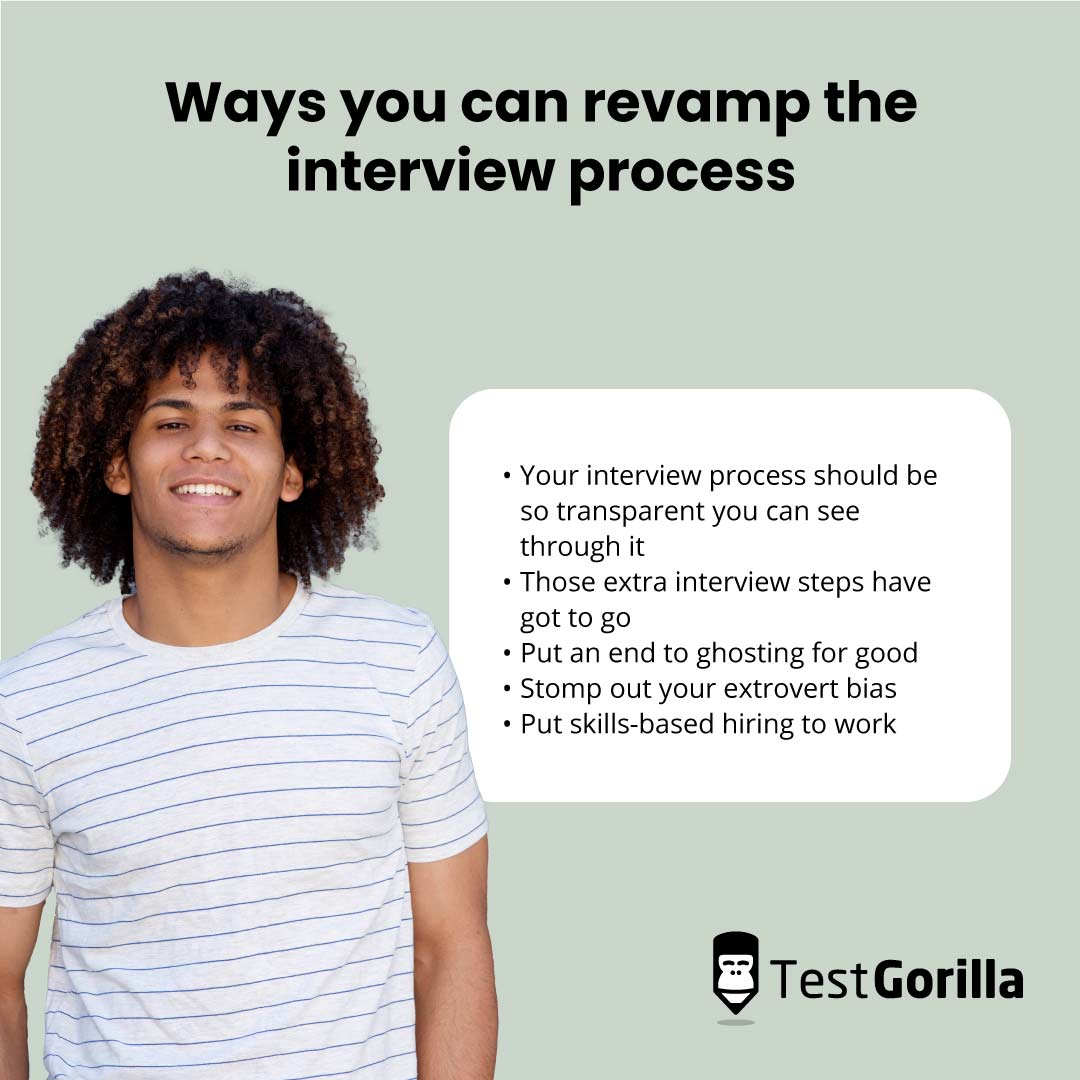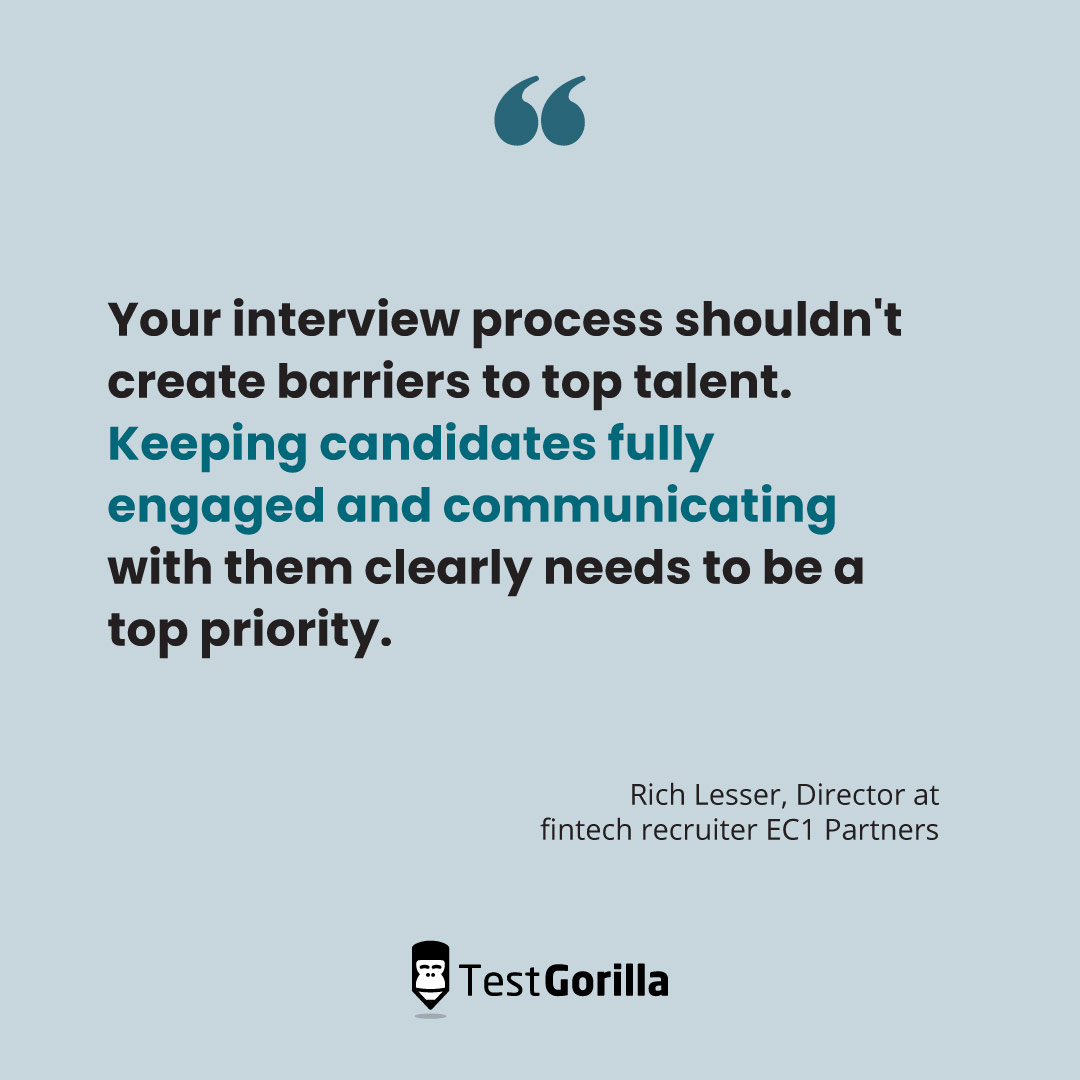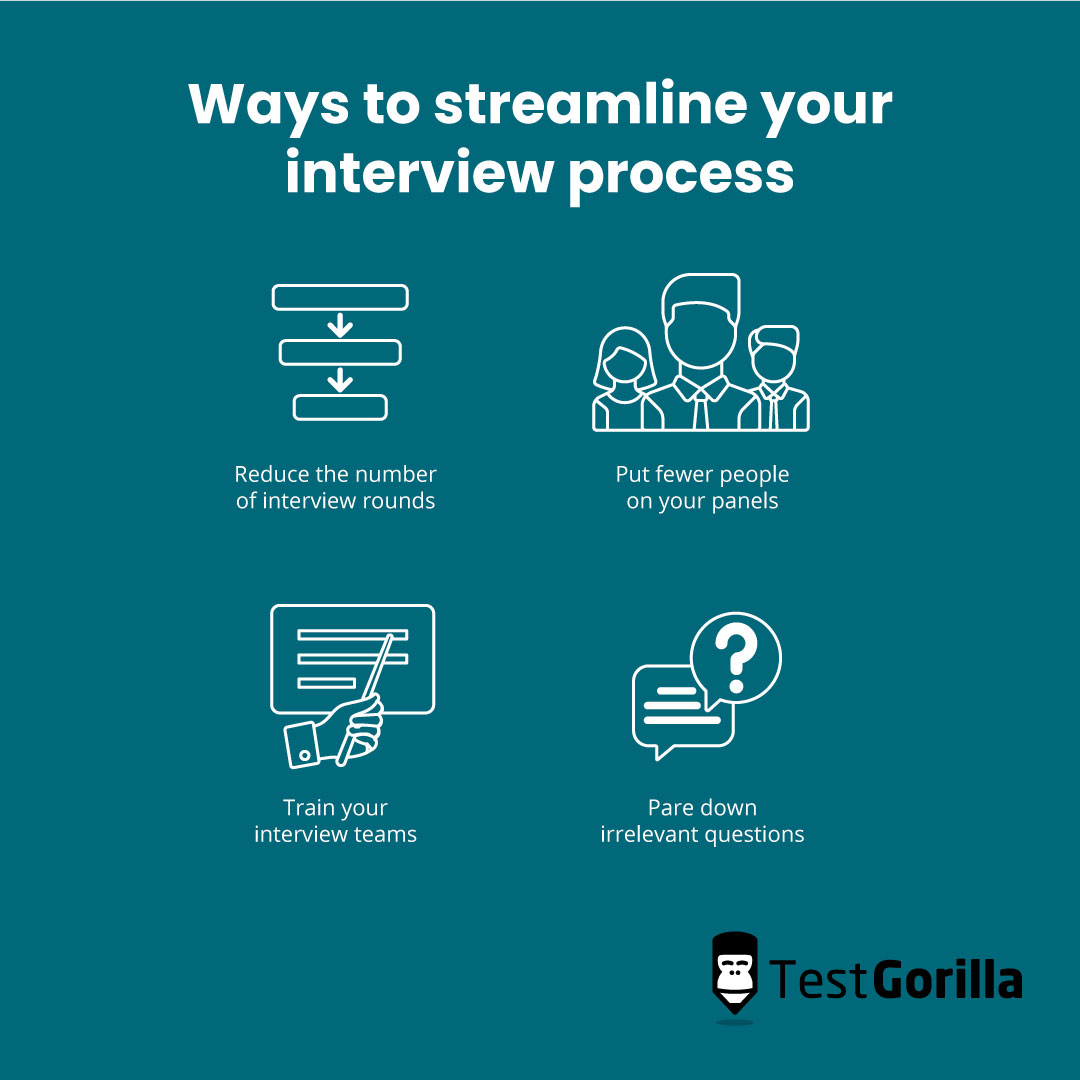Let’s be honest – job interviews have jumped the shark.
Inefficient and lengthy hiring practices have left over 60% of job seekers feeling frustrated, and there’s a growing call for companies to adopt a more modern approach. As employers, we have both the power (and the responsibility) to transform the hiring process into a more effective tool for all parties involved.
It’s time to reevaluate your interview process so you can do your part to make it more efficient, fair, and equitable. With some reflection and a few straightforward solutions, you can transform a process that feels like a chore into something you’ll enjoy.
To help you get your interviews back on track, we talked to HR experts about some of the most common issues with current practices. Here are their insights and some of our best practical tips to create an interview process that’s more effective and enjoyable for everyone involved.
Table of contents
Your interview process should be so transparent you can see through it
Keeping your interview process under wraps does no good. A lack of transparency leaves candidates frustrated and disengaged, making them more likely to pull the plug on their applications. Plus, it can damage your company’s image and harm your brand, making it harder to attract top talent in the future.
The fix for being too opaque is pretty simple – be honest and upfront, and make it easy to trust your company. Rich Lesser, Director at fintech recruiter EC1 Partners, says, “Your interview process shouldn’t create barriers to top talent. Keeping candidates fully engaged and communicating with them clearly needs to be a top priority.”
Clear and consistent communication – like how many interviews you plan to conduct and an overview of the next steps – can help to reduce the time-to-hire and improve overall efficiency. When candidates don’t have to guess, it reduces their anxiety and goes a long way toward making your company more attractive. It also holds your hiring teams accountable for completing the process in a set amount of time, which can further reduce time frames.
Offering even a small amount of feedback is a good idea too. It’s a small gesture that builds trust and demonstrates that your company is a great place to work. More than 70% of applicants want interview feedback, and over 60% say it makes them more likely to apply for future jobs at that organization.
Those extra interview steps have got to go
Throwing too many hurdles in front of your candidates during the interview process invites them to lose interest. Not only does a lengthy interview process frustrate candidates, it can cost your company a big chunk of change. The Society for Human Resource Management (SHRM) estimates hiring a candidate costs almost $7,000. If you’re needlessly dragging out the process, you’re losing even more in salaries and lost productivity.
Career coach Dr. Kyle Elliott agrees. “Talent is being pushed away by complex and lengthy hiring practices. Candidates don’t have the time or mental bandwidth to engage in lengthy interview processes or extensive take-home interview assignments.”
Take an honest look at your interview process to figure out what’s gumming it up. Whether it’s too many decision-makers, unclear hiring criteria, or excessive rounds of interviews, you’ve got a lot of options for streamlining it:
Reduce the number of interview rounds. Backing off the number of interviews is a win-win – it saves your hiring teams’ time and puts less pressure on candidates.
Put fewer people on your panels. Feedback from multiple interviewers has a diminishing return. Google’s internal research found that 94% of the time, their four-person interviews resulted in the same outcomes as those with more panelists.
Train your interview teams. Have your hiring managers been trained on how to be a good interviewer? Most likely, the answer is no. Investing in interviewing training will give your people the tools they need to create better hiring processes.
Pare down irrelevant questions. Stop asking candidates to read their resumes back to you. Eliminating redundancies and asking specific questions about a candidate’s skills and experiences will save time and give you a better understanding of who they are as humans.
Put an end to ghosting for good
We know you’re juggling multiple responsibilities, but it’s unfair to leave job seekers in the dark after they’ve invested their time and energy into your interview process. It’s disrespectful and can damage your company’s reputation. Candidates won’t hesitate to put your company on blast on social media or post negative reviews online.
Staffing expert Sara Causey has seen this problematic behavior creeping back into the interview process over the last year. “Ghosting job seekers is clearly still an area of the hiring process that remains broken. Companies that genuinely care about candidate experience have their choice of great people because they treat job seekers with dignity and respect.”
Instead of ignoring candidates, keep the lines of communication open, even if you’re unsure about their fate. Be upfront about your timelines, and If you’ve decided not to move forward with a candidate, send them a quick email to let them know (hint: sending this email usually takes one or two clicks in your HR information system). If you need more time to decide, don’t keep it a secret – let candidates know that too.
Stomp out your extrovert bias
There’s a bias you probably didn’t even know existed. Evidence suggests you may be inadvertently favoring candidates who are extroverts. Career coach Madeline Mann explains, “Being good at one’s job and being good at job interviewing are two different skill sets, yet we treat them like one and the same. Companies miss out on high-quality candidates this way and extend offers to poor performers who are good talkers.”
For example, one of Mann’s coaching clients was rejected by a company for lacking industry experience. Only a couple of months after being coached on networking and interview skills, she received a generous offer from the same company, noting she was the “perfect candidate.” Despite the short time between interviews, her skills assessment completely changed because she had stepped up her speaking game.
This bias toward extroverts can also unfairly penalize candidates who are neurodivergent, speech impaired, or non-native speakers. For instance, an individual on the autism spectrum may verbally struggle during an interview but have the skills to be great in the role.
To combat extrovert bias, look beyond standard interview questions. If you’re only asking basic interview questions like “What are your strengths and weaknesses?” you’re at risk of overlooking candidates with relevant skills. Instead, use situational questions and skills-based assessments to suss out their expertise. You can also give candidates a chance to show off their past work samples or demonstrate how they’ve applied their skills in the past.
Put skills-based hiring to work
Skills-based hiring isn’t just a buzzword. It’s a proven methodology for finding the best candidates for the job, and it can dramatically cut down on time to hire. 76% of companies we surveyed in our The State of Skills-Based Hiring 2022 report are using some type of skills-based hiring, and it’s paying off big time. Almost 92% of those organizations have seen a reduction in hiring time as a result of adding testing to their process, with some by as much as 25%.
When you employ skills-based hiring at the beginning of the interview process, it’s like having a movie trailer for each candidate that makes it easier to identify top talent faster. You also get the benefit of assessing a candidate’s expertise in the context of the role, making it easier to ditch the endless series of generic interviews.
The first step toward incorporating skills-based hiring into your interview processes is identifying the most important competencies for each role. You can do this by reviewing job descriptions and talking to the hiring managers or team members who will be working with the new hire. Once you’ve identified the top skills, you can create interview questions and use assessments designed to test those skills.
You don’t have to come up with the skills tests yourself – we’ve got plenty to choose from right here.
Related posts
Hire the best candidates with TestGorilla
Create pre-employment assessments in minutes to screen candidates, save time, and hire the best talent.
Latest posts
The best advice in pre-employment testing, in your inbox.
No spam. Unsubscribe at any time.

Hire the best. No bias. No stress.
Our screening tests identify the best candidates and make your hiring decisions faster, easier, and bias-free.
Free resources
This checklist covers key features you should look for when choosing a skills testing platform
This resource will help you develop an onboarding checklist for new hires.
How to assess your candidates' attention to detail.
Learn how to get human resources certified through HRCI or SHRM.
Learn how you can improve the level of talent at your company.
Learn how CapitalT reduced hiring bias with online skills assessments.
Learn how to make the resume process more efficient and more effective.
Improve your hiring strategy with these 7 critical recruitment metrics.
Learn how Sukhi decreased time spent reviewing resumes by 83%!
Hire more efficiently with these hacks that 99% of recruiters aren't using.
Make a business case for diversity and inclusion initiatives with this data.






















